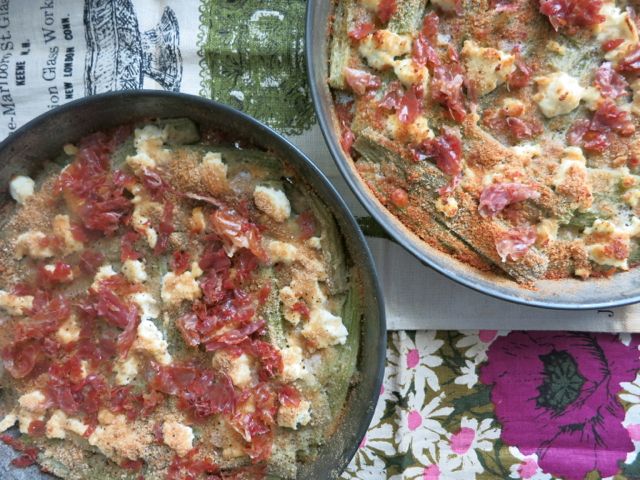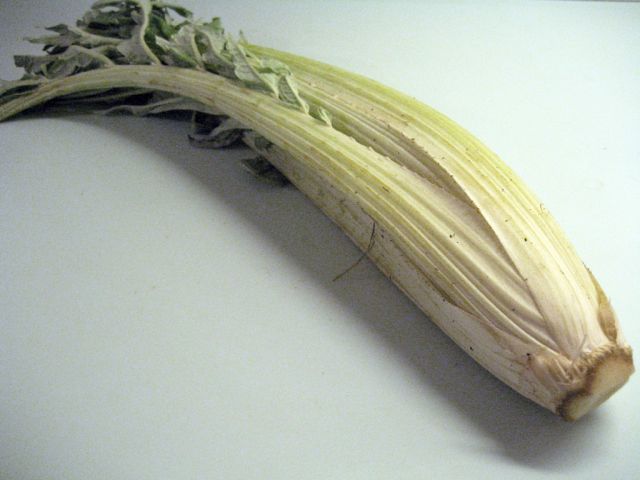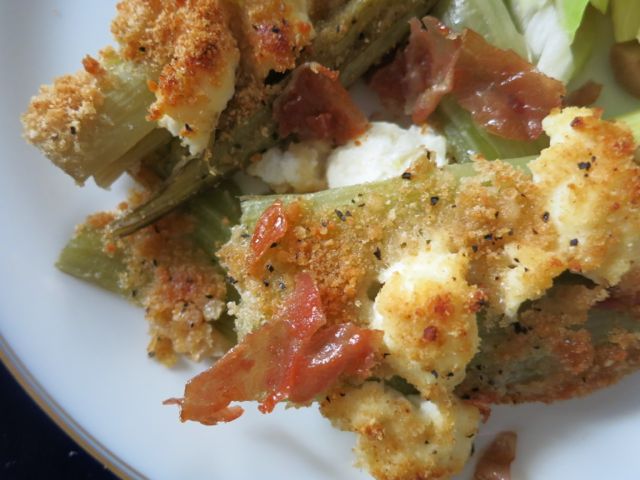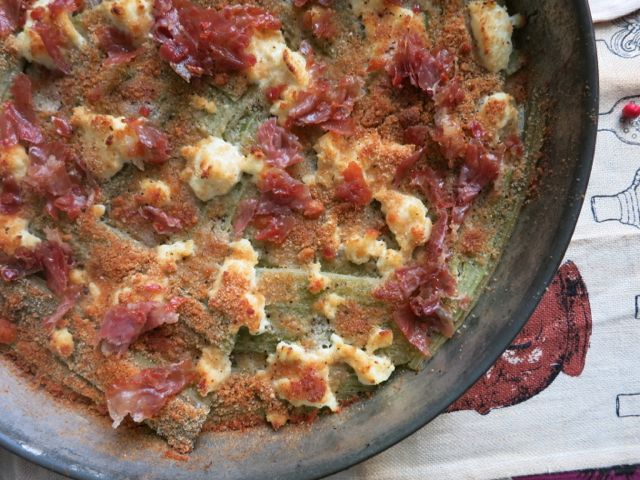
I had a funny conversation the other day in the Farmer’s market, as I was buying two huge bunches of cardoons. They sort of look like frosty celery, but on steroids. I was struggling to stuff the unwieldy stems into my shopping bag when my friend Scott asked me why I was buying them.
Um… because I love them? Because they taste delicious? “But they are such a pain to prep” he said. So I asked him, how do you usually cook them? And he replied: “Oh, me? I’ve never bought them, they are way too much trouble.”
I don’t understand how cardoons got such a scary reputation. It seems like no one ever cooks with them because they think are too much work to prepare. But – and this question is not just for Scott – how do you know how much work they are if you’ve never even bought them?!
First a bit about cardoons, or cardi as they are called in Italy. They are from the same family as artichokes, and if you go into a vegetable garden you’d have a hard time figuring out which are the artichoke plants and which ones are the cardoons. And in fact, we made this mistake in our own garden. Planting artichokes when we thought we were planting cardoons. And vice versa. Actually, we never quite figured it out.
Both plants produce a flower that looks like an artichoke. But on real artichoke plants the ‘flowers’ are much bigger and more artichoky. But on cardoon plants, it’s all about the stems.
Around the end of October the stems of the cardoon plant are tied together, while still in the ground. In Umbria they wrap them in layers of old newspaper, so that only the leaves stick out at the top. In Tuscany they often bend the entire cardoon plant on it’s side, covering it with newspaper and dirt. The point is to blanch the stems, hiding them from the light, so that they become white and tender. They continue to grow and in Tuscany they are called gobbi, since they become curved with a large hump (gobbo means hunchback) In Puglia they seem to sell them a bit smaller, and greener as well.
Regardless of where you buy them, or how they were grown, they really aren’t that hard to prep. Break each stem away from the bunch. Trim off all leafs, which are inedible and slightly toxic. Cut the stems into manageable 4 or 5 inch pieces. Then, using a knife, peel off some of the tougher strings on the outer part of the stem. (kind of like celery)
As you prep them, drop them into a bowl of acidulated water, just like you would with artichokes, so they don’t oxidize.
Once they are prepped it’s up to you how to cook them up. I’ve made risotto in the past, but also love making a simple gratin. A lot of my friends follow a traditional recipe that involves frying them stems to make a sort of cardoon parmigiana, but I like to keep things a bit lighter, to let the full flavor come through.
The taste is very much like artichokes. Which you like, right? And which you probably wouldn’t think twice about prepping, even if they are much more difficult (and expensive) than cardoons. So, go on. Buy a bunch of cardoons. Take them home. Play with them. They really aren’t that scary at all. 
Cardoon Gratin
1 big bunch of cardoons
1 cup of bread crumbs
2 cloves garlic
1/3 cup chopped parsley
salt
pepper
1/2 cup grated parmesan cheese
4 tablespoons olive oil
2/3 cups ricotta
butter
5 slices prosciutto
Prepare the cardoons:
Break each stem away from the bunch. Trim off all the leafy part. Cut the stems into manageable 4 or 5 inch pieces. Then, using a knife, peel off some of the tougher strings on the outer part of the stem. (kind of like celery) As you prep them, drop them into a bowl of acidulated water, just like you would with artichokes, so they don’t oxidize.
Once all the cardoons are prepped, bring a large pot of salted water to boil. Cook the cardoons until very tender. This will probably take about 25 minutes.
Drain well, let cook and pat dry.
Preheat oven to 350F/ 180C
In the meantime mix breadcrumbs, parmesan cheese, chopped garlic and chopped parsley and olive oil. Mix well and season with salt and pepper.
Butter a pan large enough to hold the cardoon pieces in one layer (you may have to use two pans). Lay out the cardoons to cover the bottom of the pan. Dot with teaspoon sized pieces of ricotta. Sprinkle with the bread crumb mixture. Dot with butter.
Place in upper third of oven. Bake for 25 minutes, or until it is all hot and and cheese is starting to brown.
While cardoons are baking, pan fry the slices of prosciutto until crispy. Let cool and break into crumbles.
Take out of oven and sprinkle with crumbled prosciutto.
Don’t worry if you don’t have the ricotta and prosciutto, the dish is almost as good with just the seasoned breadcrumbs. And if by now you’re totally in love with cardoons, my friend Judy has a few more recipes here and here.


think it is a good thing scott doesn’t prepare them until he reads your blog. leaves slightly toxic um.. could see them right in the dish
What a great Cardoon Primer. I love reading about how they are cultivated in the various regions, and your gratin sounds great. Thanks for the enlightenment. And happy new year!
Happy New Year to you too!
I only wish we could buy them here in our charming sea-salted Marblehead. Would be yummy on a 8 degree day such as today. Guess I’ll have to get back to Italy soon, for Cardoon.
i agree— for me there is a sort of zen about cleaning the cardoons– which i adore now! and since my husband ADORES cardoons– it wins me brownie points. i tend to go crazy now when they are in season and can’t help buying them, especially when i see nice huge big white ones. They also sell tiny ones called carducci which are actually the shoots from artochoke plants which are cut off, smaller so more of a pain to clean.
That whole thing about which ones are cardoons and which carducci is so confusing! They basically taste the same.
My Grandmother and grandfather- introduced us to them when I was younger! We would go and harvest the wild cardoons! They were and still are a family favorite! Thank you for reminding me of this wonderful memory and taste!
Janet
Wild cardoons? I’ve never heard of them before.
That looks quite heavenly. I’ve seen cardoons at Fairway, which I guess I’ll be going to tomorrow.
One of the few veggies I’ve never tried! This looks like the best kind of comfort food 🙂
Thanks for the cultivation as well as cooking information! I’ve been attempting to grow a number of Italian vegetables but advise on gardening and preparing specific to each are particularly hard to come by. My current conundrum is how to grow puntarelle to achieve the inner core of “points”, and whether or not favas should be eaten unpeeled…
Puntarelle are a bit difficult to grow. First of all you have to have the right variety of chicory, which is hard to get. Then, the seeds have to go through some cold I think to germinate. We planted them last year, but the points didn’t really get so big. I think it was because of frost.
Thank you for the cardoon introduction! I’ll be on the lookout for this gargantuan vegetable at the market. Your gratin looks sumptuous!
Thanks! Let me know how yours turns out.
How long does the cardoon season last? I won’t be in Italia til March…..I suspect I will be too late to try this super yummy looking recipe?
I am lucky to have a Sicilian farmer at my weekly farmers’ market and he and his wife introduced me to cardoons a few years ago. I love your addition of prosciutto to the gratin and will try this as soon as I see cardoons at their stand.